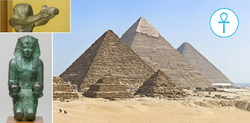- Retour accueil
- Vous êtes ici : Blog The Pyramids of the Cold The Pyramids of the Cold Section 15 • the Solvay process for natron manufacturing : the Disc of Sabu
The Pyramids of the Cold Section 15 • the Solvay process for natron manufacturing : the Disc of Sabu
Publié par Bruno Coursol dans The Pyramids of the Cold le 12/04/2022 à 20:04
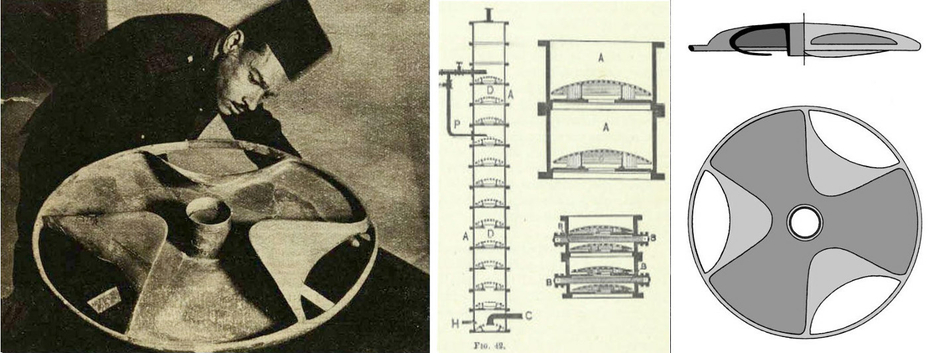
Disc of Sabu illustrations. In the center : schematic drawing of a 1800s European carbonation Solvay tower for Sodium Carbonate manufaturing, showing the segmentation layout in individual chamber units and the counterflow dome shaped discs. Right drawing of the Disc of Sabu from Wikimedia, but with its side view inverted, as it is commonly represented upside down.
The Pyramids of the Cold - Section 15 • The Solvay process for natron manufacturing : the Disc of Sabu
In summary : the disc of Sabu was most probably one of many counterflow dome shaped plates crafted over many years, that would have been set inside chemical reaction chambers, most probably piled up into towers, for manufacturing of Sodium Carbonate (Na2CO3, also called natron, the salt used by ancient Egyptians for the mummification process of their pharaohs).
15.01 The Disc of Sabu is a metasiltstone schist artifact from the first Dynasty
The disc of Sabu was discovered in the tomb of prince Sabu (around 3100-3000 BCE), pharaoh Anedjib’s son, by Walter Bryan Emery, a British Egyptologist who devoted his career to the excavation of archaeological sites along the Nile Valley. Anedjib was the fifth pharaoh of the first dynasty of Ancient Egypt.
The disc is made of metamorphic siltstone, a very fragile material that is actually a schist stone, and had been entirely carved from a single block. The disc of Sabu has a maximum diameter of 61 cm (24.01 inches) and a maximum height of 10.6 cm (4.17 inches) ; in the middle it has a hole of about 8 cm in diameter (3.15 inches).
From Wikimedia Commons : "Possible uses: mixing tool for mixing grains, with meat and water, and perhaps fruits and other. Other uses attempted - no further use, when inventor died. Tool used during large gatherings. Not a very successful design, buried with inventor. Sentimental value."
Other explanations include : "incense holder", "lotus flower shape vase" or "piece of a steam machine or turbine"...
Many theories have been written about the Disc of Sabu, but the disc couldn't have been a part of any kind of machinery involving rotating pieces of equipment or any steam machine : the disc of Sabu is way too fragile.
The common idea that the Disc of Sabu was a "mixing tool for mixing grains, with meat and water, and perhaps fruits and other" or that it was "Not a very successful design, buried with inventor. Sentimental value." is both sad and outrageous.
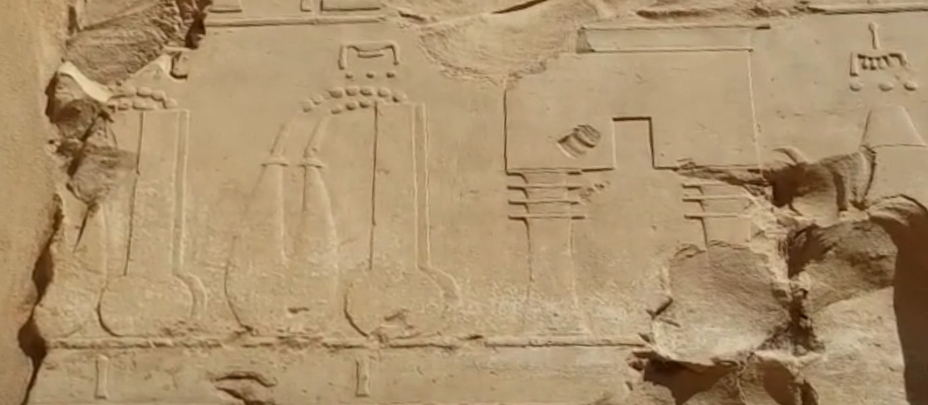
Chemistry was the real secret of ancient Egyptian pharaohs and Djed Pillars were very real structures involved in that field. Image thanks to Mohamed Obrahim : https://www.youtube.com/watch?v=1eEme-ZPc6A&t=263s
15.02 Low-Tech capabilities with infinite human and financial resources
As I have already suggested in previous sections, I believe that what we call today "ancient Egyptian gods" were actually metaphoric representations of Natron manufacturing by a Solvay-like process, that started most probably before Dynasty 1. This "quest" was nothing else than an applied research programme on the field of chemical manufacturing and it is even possible that this programme resulted in the very first Dynasty, the "Dynasty 0" or " Dynasty 00".
The first thing to consider is that ancient Egyptian scientific and technological knowledge was nothing like modern Egyptologists tend to describe.
I'm not saying they were using electricity or any other thing that fancy, but they were at the very top of what we call today "Low Technology". The Low Tech is based on very natural and simple concepts, but if you have "infinite human and financial resources" like pharaohs did, you can achieve extraordinary results.
The Great Pyramid of Khufu is the outcome of that research programme, but what we know of that pyramid today is only its lower part. That Lower Great Pyramid was designed to produce, store and transfer cold to the Upper Great Pyramid, where were most probably installed the counterflow reaction Solvay chambers.
The cold was produced by one of the most important Low Technology : the evaporative cooling. If you put very small droplets of liquid water into dry air, the water evaporates by taking energy from the air. As a result, the air loses energy and cool down.
15.03 The very first pyramid, the step pyramid of Djoser was called "the refreshment of the Gods"
If the idea of a technological role of the Great Pyramid, as a cold production unit, might seem to be troubling, let's keep in mind the official name of the very first pyramid, the step pyramid of Djoser (around 2650 BCE), that was called the pyramid of " the refreshment of the Gods".
It just turns out that this name has to be taken literally.
15.04 The Disc of Sabu and the ammonia-soda Solvay process
The purpose of this section is to demonstrate that the disc of Sabu had a key role in what was the first major technological research program of our species, and that everything we call today ancient Egyptian religion is actually referring to their technological accomplishment in physics and chemistry.
Ancient Egyptians were the first to develop the ammonia-soda process, also called Solvay process.
15.05 The 2 final magical products of the Solvay process : sodium carbonate and sodium bicarbonate
It is only since I started to work on the Red Pyramid of Sneferu that I could figure out the reason why ancient Egyptians had to produce cold in the Great Pyramid (next Section) : they were trying to master the natron manufacturing by the Solvay process, or a Solvay-like process. Since then, I only focused myself on the sodium carbonate manufacturing, because it is the purest mineral form of natron, and so I thought it was the goal of the entire process ; but it was probably a mistake : the Solvay process final products are actually 2 different components : the sodium carbonate (natron Na2CO3) and the sodium bicarbonate (NaHCO3, also called today baking soda or bicarbonate of soda).
Both have plenty of purposes, but the more important is that they were made by pure chemistry. That chemistry craft was most probably seen by the people as pure magic.
If I'm correct, the 2 libation vessels so proudly presented to us by pharaohs in so many figures and reliefs, are actually representing these 2 components.
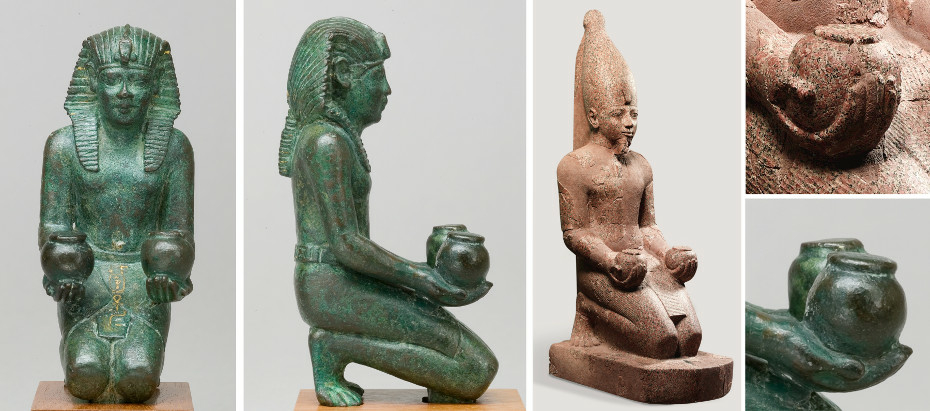
Pharaoh Amasis (left images) : Kneeling statuette of King Amasis from the Metropolitan Museum of Art, New-York. Accession Number: 35.9.3 ; 570–526 BCE : https://www.metmuseum.org/art/collection/search/544886. Pharaoh Hatshepsut (right image) : Large Kneeling Statue of Hatshepsut. Accession Number : 30.3.1 also from the MET (ca. 1479–1458 BCE) : https://www.metmuseum.org/art/collection/search/544448
15.06 The 2 vessel offerings with dark patina : the successful chemical manufacturing demonstration
Pharaohs Amasis and Hatshepsut are not shown in a purification or baptism act : they are not bringing libation vessels so that their content would be used right away ; they are demonstrating that the chemical manufacturing of sodium carbonate and sodium bicarbonate was successful.
I may be wrong, because I don't know the history of this particular Amasis figurine shown above, but it also looks like the 2 vessels have kind of a dark patina, like they were touched thousands of times, again and again for decades or hundreds of years, like worshipping people still do today on some parts of statues all over the world.
On the artifact farther below, king Taharqa is doing the same offering, but this time in front of the representations of the chemical manufacturing process heat (the falcon that eats the snake) and its cooling (snake = water = evaporative cooling).
It is said in literature that this exact kind of ancient Egyptian libation vessels are made for water purification, or sometimes for beer or wine. But if you really are planning for a religious purification act, you don't come with the lids on the libation vessels : you remove the lids. If the lids are still on the vessels, it is because whatever is inside them, it needed to be sealed off.
If it was for purification, there wouldn't need to be 2 vessels, and the lids would have been removed.
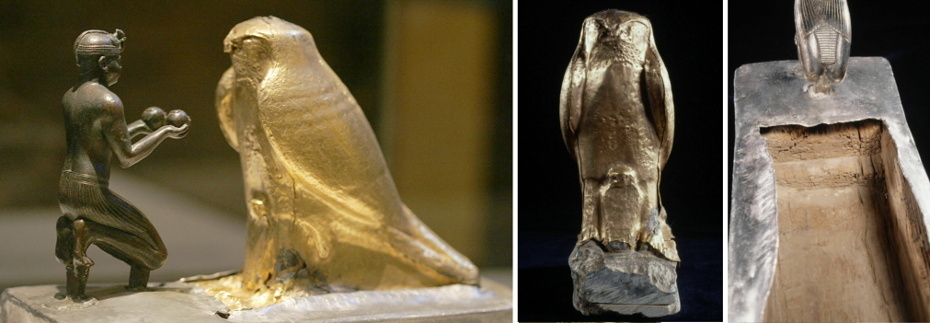
Pharaoh king Taharqa presenting god Hemen with wine E25276, from the Louvre Museum, Paris.
This amazing artifact from the Louvre Museum is outstanding, because it shows a pharaoh kneeled down in front of the representations of the heat generated by the chemical manufacturing (the falcon) and the cold production (the snake), both put on the representation of the impactor of the grand gallery / inclined well : the wooden hollow base of the figure.
15.07 King Taharqa is thanking the gods for the successful chemical manufacturing
There is no offering in this scene : the pharaoh isn't giving anything to anybody and he is even not physically connected to the rest of the artifact because he is not part of the action.
That is the falcon and the snake who gave the content of the bowls to him.
The falcon is a metaphor of the natron manufacturing heat and the snake represents the cold made out of water that cooled down the reactions.
King Taharqa, like Amasis and Hatshepsut, is simply thanking the gods with the highest respect for giving him the 2 bowls content, and that is certainly not wine as indicated in the data sheet of the artifact, but very much probably sodium carbonate and sodium bicarbonate if I am right about the Solvay process.
The fact that the snake is gently put between the falcon's legs, is also a perfect metaphor of the balance achieved between the heat of the Upper Great Pyramid chemical reactions and the cold produced by the Lower Great Pyramid.
The falcon and the snake should engage into a mortal combat, but they are not, they have been perfectly domesticated ; the heat and the cold have been perfectly mastered.
15.08 The snake predators feeding metaphors of the cold production
We've seen in previous posts that the key element of the cold production process in the Great Pyramid, was water and that it was represented by a snake. The great amount of pressurized water inside the inclined well was represented by the Great Serpent Apep (Apophis) and the small amount of water injected inside the evaporative cooling passage was represented in the Dendera reliefs by a small snake.
So the snake is a representation of the cold, and that cold was transferred to the Solvay towers. It is like the Solvay towers were fed with the cold. That explains why so many animals that are eating snakes as a regular diet, appear so often in ancient Egyptian religion scenes.
The mongoose, the hawk and vulture, the crocodile, the cat, the ibis... all of them are snake predators : they are nothing else than cold feeding metaphors for the Solvay reaction chambers.
15.09 The chemical manufacturing as a legitimacy to reign demonstration
These statues of pharaohs holding the 2 vessels, would also reinforce the idea that part of pharaohs legitimacy to reign was coming from their ability to demonstrate their mastering of the "magical" chemical manufacturing to their people.
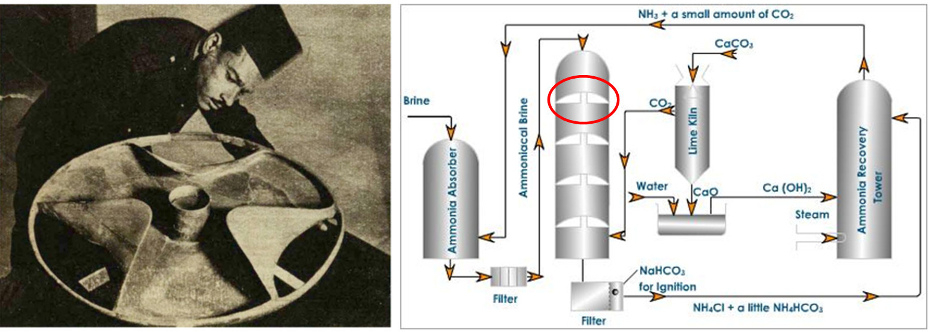
Schist discs like the Disc of Sabu (First Dynasty) were used inside Solvay-like towers as dome shaped and perforated plates for counterflow chemical reactions, probably until way after the end of the Fourth Dynasty.
15.10 The counterflow chemical principle is the key of the Disc of Sabu original function
The Solvay process used in the Sodium Carbonate manufacturing, is based on the counter current principle : the brine, saturated with ammonia NH3 gas, slowly passes through the carbonating tower, from top to bottom, while carbon dioxide CO2 is injected at the bottom of the tower and forced to top. Brine and CO2 are both passing through the perforations of the mushroom shaped plates, counterflow.
15.11 One Disc for 2 possibilities of counterflow chemical reactions
Other the years, probably dozen or hundreds of discs, identical or similar to the tri-lobed schist disc of Sabu, would have been crafted. There could have been 2 major uses for such Discs :
• The ammonia saturation of the brine
The 50% salt concentration brine had first to be saturated with NH3, ammonia gas. The brine was poured on the top dome shaped side of the disc and the NH3 was injected at the bottom of the unit or the tower so that the liquid and the ascending gas would react through this counterflow design.
Typically, this is the saturation tower of the Solvay process.
• The carbonation of the ammoniated brine (more likely), as shown in the diagram below
Once the brine is saturated, the same process takes place, but this time this is the ammonia saturated brine that is gonna be reacting with an ascending flow of high temperature CO2 coming from the limestone kiln.
Typically, this is the carbonation tower of the Solvay process.
15.12 Europe / Ancient Egypt : From the glass industry to the chemical manufacturing industry
In Europe, the Solvay process was invented in Belgium in 1861 by the chemistry industry, after it had mastered the glass industry.
What is really interesting to note, is that every scholar agrees on the idea that the first ones who mastered the glass manufacturing process, were the ancient Egyptians, 5000 years ago. That is 500 years before Sneferu's reign and the Great Pyramid. 500 years to discover and master the Solvay process.

On the left is the lower part of the Red Pyramid descending passage (looking up, we can see the sky) and showing only the natural color of the stone blocks. On the right is the same passage (looking down, towards the first chamber), above the lower section, and showing red and yellow deposits both onto the ceiling and the walls.
The big pipe on the floor is going to the "burial chamber" and is supposed to bring fresh air, or get rid of most of the ammonia smell (I don't know if air is pumped in or out of the chamber).
Where the ceiling has been recently damaged, we can see the natural color of the stone. Red and yellows really are deposits, they are not the natural color of the blocks : some activity inside the pyramid, after the passage was built, was responsible for their presence.
15.13 The red deposits on the Red Pyramid descending passage and the ferrite iron of the disc
The schist material in which the Disc of Sabu is made of, contains a mineral with a very high concentration of iron : the ferrite. It is possible that the red deposits that are still visible inside the descending passage of the Red Pyramid (mostly on the ceiling), are coming from this ferrite mineral. The heat coming from the limestone kiln CO2 would have extract ferrite iron from discs of Sabu and it would have then deposit itself in the passage, where it would have rust and turn red.
It is still unclear to me where the yellow deposits we can also find in the passage are coming from.
15.14 Water, heat and cold insensibility : the metamorphic schist resistance properties
The disc of Sabu is made of a very particular stone that gives to it properties perfectly fit for the job : the metamorphic schist. The disc would have been placed inside counterflow chemical reaction towers (the Djed Pillars) or units (the Abu Gorab stone basins) and submitted to very harsh conditions : the disc would have been in contact with very concentrated brine (50% salt solution or more) and saturated with ammonia NH3 and with very hot CO2 gas. Also, as we can see on the Abu Gorab 3 holes cracked stone basins, the different units, stacked or lined up, would have been cool down and subject to high levels of thermal stress.
Schist is completely waterproof and insensible to cold or hot temperatures.
Metamorphic schist isn't sensible to fire or frost damaging. These properties explain why, in many regions of the world, this material is used to cover house's roofs : slates are made of metamorphic schist.
15.15 The metamorphic schist weakness : its fragility
The brittleness of the schist explains why it is mostly only used nowadays on roofs : it isn't supposed to get hit by anything. The same way, the disc of Sabu was perfectly secured inside the towers or the individual units they were in : the only stress the discs of Sabu would have been subject to, was thermal and chemical.
That thermal stress problem was what caused the discs to break, and that is the origin of the Eye of Horus broken into pieces myth (see more in the next Section about Horus).
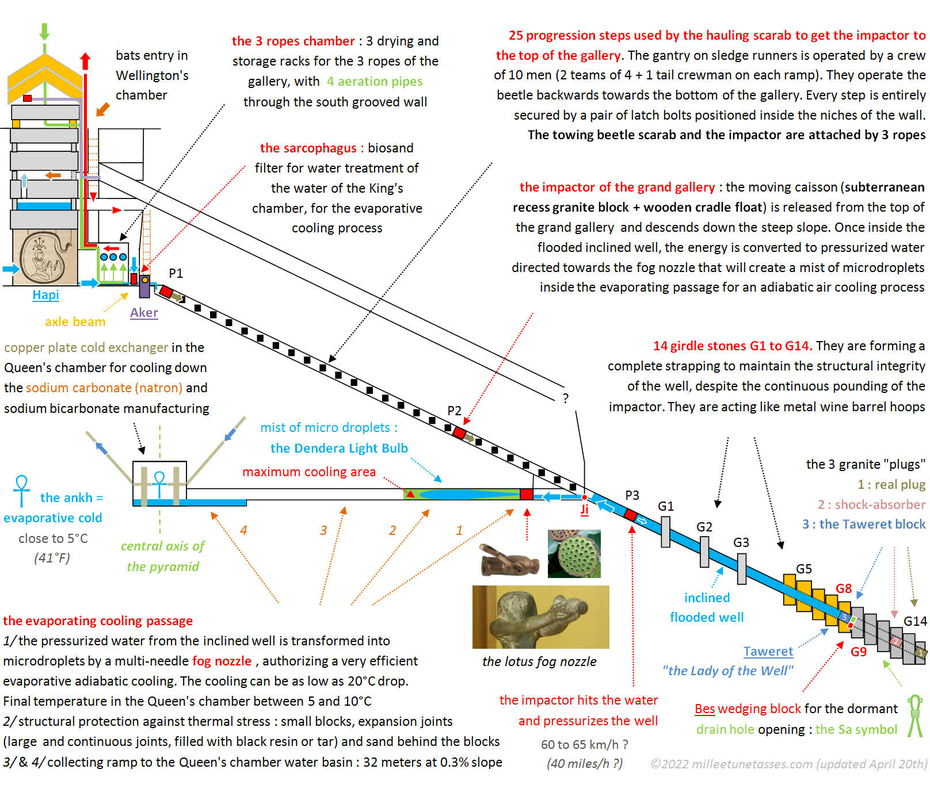
Diagram of the Great Pyramid of Giza in operation, before the shutdown procedure and the draining of the inclined well.
15.16 Summary of the study : hidden behind the academic vision of the ancient Egyptian religion, a vast number of metaphors are describing some of the most advanced science and technological knowledge of that time : ancient Egyptian gods were nothing else than pharaohs' metaphoric self-glorifications of their theoretical and experimental scientific accomplishments in physics and chemistry.
Pharaohs used the power of Science to legitimate themselves as kings of Egypt : they forged an entire religion, based on science to rule their kingdom, and they presented that science as Magic.
The end game of this technological program that probably started on the very first Dynasty, was the Great Pyramid of Giza where evaporative cooling was engineered in the known part of the pyramid from the pressurized water produced in the inclined well, known today as the ascending passage.
The evaporative cold simply took advantage of the power of water, and was most probably necessary to cool down chemical manufacturing of sodium carbonate and sodium bicarbonate produced by an ammonia-soda Solvay process, as suggested by the very strong ammonia smell and the limestone kiln in the so-called burial chamber of the Red Pyramid. At that time, sodium carbonate was called natron, and it was the salt used for the mummification of the pharaohs (Sections 14, 15 and 16).
The cooling seems to have represented the most difficult part of the process, as suggested by the Step Pyramid's official name : according to scholars, the very first pyramid complex, the Step Pyramid of Djoser, was called "the refreshment of the Gods". No doubt that a more accurate translation would certainly be "the cooling of the Gods".
It means that ancient Egyptians were the first civilization to master a Solvay-like process for sodium carbonate manufacturing, long before it got reinvented in the 1800's in Europe. The key elements of that process is the temperature control of the chemical reactions (the cooling), and the dome shaped plate necessary for the counterflow chemical reactions to occur in an efficient way. That counterflow reaction plate is what really is the disc of Sabu.
As shown with Akhenaten and Nefertiti, the creation of the evaporative cold was the most sacred accomplishment of all (Section 17), and this is exactly what the Dendera Light is all about : the Dendera Light is the fog of microdroplets of liquid water that evaporates and creates the cold. Talking about the snake inside the Dendera Light Bulb : "The field surrounding Ra’s snake form is referred to in ancient Egyptian literature as protective magical energy in liquid form that all gods and pharaohs possess" (Faulkner, Section 2).
Everything that had been done in the Great Pyramid of Giza inspired most of the ancient Egyptian religion, and it had been glorified into what we know today as the Underworld.
The Underworld is referring to the chambers and passages of the Great Pyramid of Khufu, and in particular to the Grand Gallery where a hauling gantry beetle operated a wooden coffin shaped impactor that had a small nested granite block inside it. The impactor generated endlessly, over and over, maybe every 15 minutes the pressurized water that was then transformed into a fog of microdroplets inside the horizontal cooling passage.
The Grand Gallery of the Great Pyramid where the act of hauling was done, is the "Secret Hauling Cavern of the Underworld" described in the Amduat "Book of the Hidden Chamber".
The most important chamber of the Great Pyramid wasn't the King's chamber that only was the main water tank of the pyramid, but the Queen's chamber, the only one on the central axis of the pyramid. Because the Queen's chamber was inaccessible from the rest of the pyramid, it was glorified into the "Hidden Chamber of the Underworld" (Section 11), and because the Queen's chamber was the coolest place in the pyramid (about 5°C / 41°F), and with a constant 100% Humidity rate, this chamber was the one where the biggest amount of very hard salt encrustation had been documented by the first explorers of the pyramid in the 1800's and before it had been removed in 1998 by Zahi Hawass (Section 1). Very hard salt encrustation is the signature of the evaporative cooling process, even nowadays.
The most incredible thing is that pretty much everything I've just said, actually appears in one single myth, but it doesn't originate from ancient Egypt : it is the "Churning of the Ocean" Hindu myth that produces the immortal nectar Amrita. The fact is that the endless churning of water that ends up with the production of an elixir that gives eternal life, is exactly what were doing ancient Egyptians in the inclined well : natron was the salt used for the mummification of pharaohs.
Natron gave eternal life to pharaohs, just like the Amrita (Section 19).
Poster un commentaire

